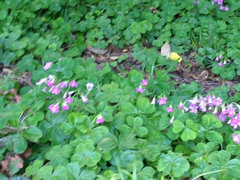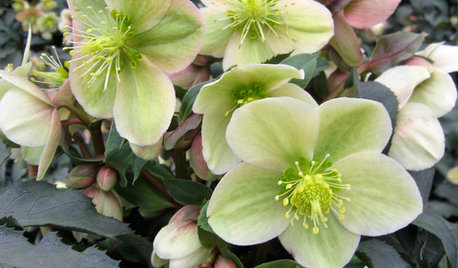Oxalis mystery
My sister's had this Oxalis (indoors) for some 20 years. The top of the foliage is green, and the undersides are a light purple. The flowers are white. The closest we've been able to find Online is Oxalis triangularis 'Fanny', but the similar ones On Google images are on individual Flikr accounts. The nursery images for 'Fanny' are green with white/silver variegation.
{{gwi:139364}}
Comments (44)
Carrie B
Original Author10 years agoMost of the regnellii photos we're seeing Online have very dark purple foliage, which this one definitely does not have. Are there subspecies of regnellii?
Related Professionals
Canton Landscape Architects & Landscape Designers · 70037 Landscape Architects & Landscape Designers · Folsom Landscape Architects & Landscape Designers · Hyattsville Landscape Architects & Landscape Designers · Zion Landscape Architects & Landscape Designers · Maple Heights Landscape Architects & Landscape Designers · East Patchogue Landscape Architects & Landscape Designers · Buford Landscape Contractors · Frisco Landscape Contractors · Euclid Landscape Contractors · Eureka Landscape Contractors · Fair Oaks Landscape Contractors · Lakewood Landscape Contractors · North Highlands Landscape Contractors · Pomona Landscape Contractorsken_adrian Adrian MI cold Z5
10 years agothe red coloration of any plant is highly subjective to proper growing conditions.. and indoors.. that would be proper light levels ...
its one thing to have enough light to live.. its might be another thing as to whether it colors properly ...
MANY variegated/red plants.. go towards all green.. to maximize chlorophyll ... food production .. in low light..
balancing against such.. is the fact that it flowers ... which would probably indicate sufficient light ...
all said... it might simply be hard to compare your house grown plant.. with nursery grown plants.. and ever definitively ID the plant ... though i have high expectations of this group to do it ...
a better picture MIGHT help .. its hard to gauge color with the light source behind.. and shining thru the leaves ...
in any cultivar name provided... some research should tell you when it was introduced ... and your 20 year old plant.. might not be a plant intro'ed 10 years ago ...
good luck
ken
Carrie B
Original Author10 years agoIt may very well be a cultivar (or variety?) of triangularis, but it is not a deep purple (as a matter of fact, it has a purple blush on the back of the foliage, but not front) like the triangularis I see Online.
Tiffany, purpleinopp Z8b Opp, AL
10 years agoHmm... Is it going dormant, just woke up, actively growing?
Have you tried putting some outside in the ground (not at this time of year, of course?) AFAIK, the cultivar 'purpurea' is what's usually sold, a very purple cultivar. You may have the 'plain' species? I couldn't find a reliably-sourced pic representing the plain, non-cultivar species either.
Purple leaves often do not turn yellow from chlorosis, but can go gray, pink, orange, green. Maybe a nutrient issue? In insufficient light, many purple leaves are green. Possible?
I lightened the shadows of your pic a bit. I don't think it's at the height of vigor at the moment, and gives me the impression it could be more purple, though 20 years is a long time to observe only this color. Does it ever look really happy, vigorous, packed with upright leaves & flowers?

Carrie B
Original Author10 years agoYes, I'm pretty certain that the color is the color - not due to light, nutrients, etc. The foliage folds up at night and opens in the light. And it's consistently green on the tops of the leaves with a purplish underside. The flowers are white.
Tiffany, purpleinopp Z8b Opp, AL
10 years agoIt doesn't look unhappy for being in a pot, better than the 1st pic made it look, and happy enough to make the flower. I'm sure it would have a much more vigorous look outside in the ground, if you're interested in giving it a summer home. I would be curious about leaving some too, to see if it's hardy.
After 20 years, the bulbs should have multiplied a lot (and maybe they have, no longer in this pot.) I had no idea until a minute ago, there are over 800 species of Oxalis, though I couldn't find a pic of any that are green on top, purple on the bottom.
Wiki (O. triangularis article):
"The leaves of O. triangularis move in response to light levels, opening in high ambient light (in the day) and closing at low light levels (at night). This movement is not due to growth and is instead powered by changes in turgor pressure in cells at the base of the leaf. It is an example of photonasty." (Cool word. I guess that's what Maranta and Calathea do.)I don't think all Oxalis do that, so probably a clue, but I gave up trying to find if all Oxalis do that, or only some species, or even just this one species.
The above article also suggests the plant usually sold as purple shamrock is a subspecies, O. triangularis subsp. triangularis. How does it differ from the straight species? Doesn't say & apparently the whole internet is suffering from extreme lack of curiosity about it, according to the search words I used.
BTW, how did it take 20 years for curiosity to get this far? Don't remember the last time anybody said an amount of time that long about a mystery plant. Fun!
Carrie B
Original Author10 years agoThe plant is my sister's, and she lives in a different city (and state) from me. It's only in the past half a dozen (or so) years that I've really become interested in plants - and even then, mostly outdoor plants. I'd be willing to bet a good amount of money that this Oxalis is not hardy in zones 6/7, where we're located (Philadelphia/Baltimore.)
Last night, I stayed at my sister's with a colleague, who is also a gardener, and she's joined my curiosity. So, now there are two of us. My sister's response is something like "oh, I don't know, it's just some Oxalis I've had forever."
This morning (perhaps for the first time ever) we divided the plant - I took a small piece to take home, as did my colleague. It's been in the same little plastic pot for many years - perhaps the entire time my sister's owned it.
We've now spent HOURS Online, and not come up with much.
Tiffany, purpleinopp Z8b Opp, AL
10 years agoI'm glad to hear it's been trifurcated, more to observe. O. triangularis is reportedly hardy to 6b, but not knowing if that's what it is, the info is meaningless until an ID can be established. If it does well enough, you may have enough this fall, or next year, to feel like dedicating some to experimentation, if still in question about ID (hope not!)
I'm curious, did you happen to take pics of the division process? I was fascinated the first time I closely examined the bulbs of the Oxalis I have. There are two different kinds of bulbs, the upper ones that sprout the foliage, and lower ones that look like strings of mushed-together spheres. If separated, both will grow. Wild stuff!
Also probably why folks say "digging it up doesn't get rid of it" when they have bulb Oxalis they don't want. If you only get the upper bulbs, you've really only 'pruned' it.
This summer, the purple Oxalis I have should be significant enough to divide. I can't wait to see what the bulbs have done under the surface.
I think it's extremely difficult to grow seasonal bulbs alone in pots, I'm a serial overwaterer in constant recovery. If you have space on the soil surface of an existing plant, it would be a lot easier to not rot it with too much water, or dry it from too much well-intentioned neglect. Don't remember hearing about an Oxalis in a same pot for 20 years. Kudos to your sister for this accomplishment!
Good vibes to all 3 'sections' of this now!
I laid this plant/bulbs on the paper as closely to how it was arranged in the ground as I could in "2D" laying on a flat surface. The roundish foliage-sprouting parts are at the surface, but the sphere-strings are 2-4 inches under.

jaynine
10 years agoBrent & Becky's offers O. regnellii (syn. O. triangularis) with a description that sounds like yours, though they don't show a pic of the reverse.
Here is a link that might be useful: Brent & Becky's
Carrie B
Original Author10 years agoThanks, Jaynine. I did see that link, and that could very well be what I have. What I'm finding confusing is that the vast majority of Google images & websites for O. Regnellii (& O. triangularis) have deep purple leaves throughout.
Perhaps what I have is the straight species that is largely forgotten in the trade, or that there's a good deal of individual variation (though this seems different enough to be at least a different cultivar) or that perhaps they're different subspecies or cultivars or even that one of the two is largely mislabeled.
I just can't figure it out. If what I have is O. Regnellii - then what are all those purple ones that are labeled as such?jaynine
10 years agoIt's confusing: pics of the purple ones are shown labeled O. regnellii, O. regnellii 'Triangularis', 'Purpurea', 'Atropurpurea', O. triangularis subsp. papilionaceae 'Atropurpurea', O. triangularis ssp. triangularis (and more).
Tiffany, purpleinopp Z8b Opp, AL
10 years agoO. regnelli is a synonym of O. triangularis. The capitalized words inside the apostrophes are cultivar names.
This post was edited by purpleinopp on Fri, Jan 10, 14 at 15:03
Carrie B
Original Author10 years agoThanks, Jaynine & purpleinopp. So, I guess it remains a mystery, right? We can think it is regnelli, but who knows?
Embothrium
10 years agoIf more purple clones are being maintained by asexual propagation, with inferior, less purple forms resulting from raising plants from seed then that could explain what you are seeing in pictures. If this is the case, adequately written accounts of the plant(s) should mention it. If none such have been put up on the internet, you may have to go to a library with a good assortment of plant books and crack a few of these open to discover the answer.
Tiffany, purpleinopp Z8b Opp, AL
10 years agoAs young as this post is, hours, I wouldn't go anywhere near giving up yet.
Looks like a nice piece of bulb, BTW.
I don't think anybody ever asked, does your sister happen to remember acquiring this plant? From a store? BBS or M'n'P? Time of year?
You may want to put a link to this on house plant forum, where many have watched various potted Oxalis both struggle and thrive, someone over there might have seen this.
One last thought, triangularis means 'with three angles,' so knowing if other O's can have leaves that shape could help.
Later this summer *when* it is looking fantastic from your excellent care (and better weather,) add a new pic here if remains undecided.
Carrie B
Original Author10 years agoPurpleinopp - great idea about putting a link on the houseplant forum - I'm going to do that! And I'm so glad you don't think I should give up. I'm usually quite good at Internet research, and the fact that I've spent hours, with considerable help...
My sister got the plant as a gift many, many years ago. I believe it's been in its little plastic pot ever since, and this morning may be the very first time it's ever been divided. I'm also pretty sure it's lived on her windowsill (perhaps the same one it's on now) for all that time.
I've admired this plant several times over the years, sometimes it's more floppy than others, and sometimes it has flowers & sometimes not, but the coloring remains the same.
I'm off to post a link on houseplants!
Carrie B
Original Author10 years agoOh, btw, my sister reports that she's almost killed this plant many times, but that it always comes back.
A friend on my FB post (with my plant-knowledgeable friends tagged) added a photo of what appears to be the same plant at her house - she says that she has four of them that she's almost killed from neglect many times & that always seem to survive her neglect - that friend said that a friend of hers dug them up from her Florida yard "growing wild" many years ago. That friend, the one who got her plant from Florida, keeps them indoors in her Maine home.
They actually seem like pretty tough plants. I prefer their look to the dark purple ones - I find them more delicate and subtle.
Tiffany, purpleinopp Z8b Opp, AL
10 years agoThese do go dormant periodically, whenever conditions aren't optimal (light, temp,) or just needs a rest, so I wonder if that's what's happening when people say they were almost killed? That's what I was referring to when I was saying I would have a hard time not killing them. Going dormant looks the same as dying. Bulbs are definitely tough, but I could still rot them I'm sure.
If it came from a store, that narrows down the possibilities to the few kinds that would be sold in a pot. So I wonder if it's Oxalis acetosella?
Being in the same pot for 20 years, it's hard to imagine that it's had optimal conditions, especially if watered with tap water, which would likely raise the PH over time from lime, as well as deposit chemicals plants don't usually like, like fluoride & some kind of chlor-. I wouldn't rule out the possibility that it could make purple leaves in an optimal setting/conditions (if it's O. triangularis/regnelli.)
Two other purple plants come to mind that usually turn green over the course of being inside for winter, less than 4 months here. If one always keeps them inside, they might say/think they have an unusual Tradescantia pallida or T. zebrina that only makes green leaves. Persian shield (Strobilanthes dyerianus) does the same thing, usually not enough light inside for it to be the bright purple of outside.
floral_uk z.8/9 SW UK
10 years agoI've no idea what this Oxalis is but I can say for certain it isn't Oxalis acetosella. That's our native wood sorrel. The leaflets are heart shaped not triangular, much smaller than the ones in the picture and light green.
Here is a link that might be useful: Wood Sorrel
garyfla_gw
10 years agoHi
i have 3 kinds deep purple with black markings pink flowers . A green with black markings white flowers and a plain green with yellow flowers Have no idea which they are Did I confuse you more?? Might add that the plain green is summer dormant garyCarrie B
Original Author10 years agoThanks, again, everyone. It remains a mystery, but I'm more OK with that now than I was. One of the people I reached out for in trying to ID this plant was a garden writer named Barbara Pleasant. She had an article about Oxalis posted Online, with a "contact me" link. So I did.
Here's what she had to say:
***
Hi Carrie,
Thanks for getting in touch about your family oxalis. What is your sister's name? I think you should name it after her, because we will have little luck running down a valid name. Good job trying, though. The only way to research plants is to use botanical names, which you did. That and Google images, but the pictures often are inadequately or incorrectly identified, so that ends up being a rabbit hole, too.
Twenty years ago was pre-interweb, and names have never been important in this particular plant market, which is very seasonal. Various shadehouse growers in Florida, Texas and S. California maintain their own strains, which they propagate in winter so the plants will be robust for sale as St. Patrick's Day shamrock plants. In March the box store garden centers will have zillions of modestly-priced plants, but the names on the labels won't mean much -- if the plants have labels at all.
In addition there are collectible variegated oxalis you would definitely want to buy by variety name, for example the ones sold by Logee's Greenhouses.
I like passalong varieties of all kinds of plants anyway. Knowing where they came from gives them staying power. Good luck with your new oxalis! When the fresh foliage comes on, it will look so pretty.
Barbara***
Kind of makes sense to me. Am still welcoming any other thoughts people have.
rhizo_1 (North AL) zone 7
10 years agoI inherited a large Oxalis many years ago....green foliage and white flowers. It remained full and lush for decades as long as I allowed it to go completely dormant for a month or so every year, and as long as I repotted, divided, or potted up occasionally.
I kept it in a very bright location in the house during its growing months, fertilizing as with my other houseplants. It stayed so covered in flowers that the foliage was nearly hidden.
I also enjoyed a purple one for many years. Also subdivided numerous times, it and the progeny lived in pots and baskets outside in the full, blazing S. Carolina sun where they thrived all year round. Again, a few weeks of full dormancy is important, as is regular fertilization.
I didn't even try to grow that one inside as I knew that the performance would never come close as in the full outdoor sun.
Tiffany, purpleinopp Z8b Opp, AL
10 years agoTY, Flora! I got dizzy trying to decide which pics of O acetosella were 'the right ones.'
Carrie B
Original Author10 years agoDo you think we can say for sure this mine is O. triangularis of one type or another?
Tiffany, purpleinopp Z8b Opp, AL
10 years agoIDK, Carrie, but it's definitely an appropriate description.
Gary, forgot to ask, is your yellow-flowered plant a bulb? If not, it's probably O. stricta, not a garden-worthy plant IMO. Toooo seedy. If you can recognize the difference, the way O. stricta starts to branch even when very small, much smaller leaves, sometimes a reddish tint to it, you can pull them before they even bloom. If the ground is moist they usually let go instead of breaking.
If the flowers look more like yellow fuzzy balls, could be a Medicago. There's some in DH's Mom's hard with a red heart on each leaf. (M. arabaca I think.) I've been trying to transplant some to our lawn but no luck so far.
garyfla_gw
10 years agoHi
Actually none of them are garden worthy in my location ,
very invasive but in a nice way lol Don't have a single pot,planting area with out some lol The purple is the most prolific The green is rather slow , there is also a weed which must be in the same family Green leaves without black and pink flowers believe it's in the sorrel family I usually let it grow as it's smothered in flowers not leggy and is summer dormant.. garyTiffany, purpleinopp Z8b Opp, AL
10 years agoGary, I think we've had a similar conversation before. You're still benignly detesting your Oxalis? I'm as big of a fan of mine as ever, more. LOL! I love it.
I couldn't find the last plant you described but it sounds very cool. (Assuming you meant with black & pink flowers, not without.) If you get in a mood to share a pic, I'd love to see it. It needs a name anyway, right?
I think these bulb Oxalis (that I have so far, crassipes, triangularis) are an awesome ground cover for shrub beds. The foliage comes up to shade the ground before most weed seeds try to sprout, stays under a foot tall, blooms prolifically and early, attractive to look at, dies down quickly when going dormant, dormant in summer so weeds can be seen and pulled, evergreen in mild winters, easy to remove a 'plug' to add a new plant, doesn't creep like almost every other ground cover (though does make seed,) not at all picky about exposure, and can be mowed. Speaking of which, that's how I got so much, sifting through the grass we dug up to make beds. I saved the Oxalis bulbs.
I'm working on making a solid cover or at least border of it in all of my beds since I love it so much and it's capable of helping to keep the grass on the lawn side of borders, above and below ground. Oxalis and Liriope are stereotypical border plants around here, I'm just monkey-do'ing what I've monkey-seen, though I usually detest stereotypical plantings. When they work so well, and it happens to coincide with one's visual pleasure, join the unbeaten I say!
Do you get into trading? You could trade Oxalis bulbs for a lot of other plants. When I offer them in trade, most people want some. I have no idea what your collection is lacking though. Anything at ALL?
When I've had to dig former-houseplant weeds out of our yard, DH's Mom's & my Mom's yard, I found people who wanted them for postage. Spider plants, Callisia fragrans, asparagus ferns, variegated Vinca vine, went to homes up north, back into the pots in which they belong. Didn't lessen the work of the digging, but it was a lot of fun to send them away in a box where they can be enjoyed without invading a garden. Maybe it would work for you too? The purple-leaf kind, you'd have more takers than bulbs - as long as you don't ONLY ask folks in FL.
RebeccaDiane Williams
7 years agoI too would like to find this plant. We had one for over 50 years until someone used bleach water to "water" the plant.
Carolina Girl (Zone 8b)
7 years agolast modified: 7 years agoI have tons of wood sorrel. I'm happy to ship some off for postage!


jenda07
6 years agoHi, I obtained one of those plants from a coworker who no longer works here and everyone at works loves it and wants to know what it is called. But like you I have only found info on the oxalis triangularis and the oxalis regnelli but I can tell neither are exactly like this plant. I know this was an old post but was wondering if you ever discovered what this plant is actually called?
Stephanie M
3 years agoMy plant looks exactly the same! Green on the top leaves and purple on the underside. My mom got it at the supermarket and does not know what it is called either. I found your post because I am trying to sort that out myself!
four (9B near 9A)
3 years agoThe thread originated seven yrs ago, which is not a limitation. Her recent contribution gave it currency : It received a response from you, and from me, and undoubtedly a look from others.
paige
2 years agoJust chiming in to this 7 year old thread to say that I bought a plant called "Oxalis Triangularis" on Etsy last month that fits exactly this description. It came in purple and green varieties. I was curious if the red/purple undersides were a sign of stress or just part of the plant, which is how I arrived here. There is very, very little information about the green version of this plant and I was so happy to learn more.
Carrie B
Original Author2 years agoMy sister has had hers for many more years than I’ve had mine, and the underside has always been purple.
Stephanie M
2 years agoI stumbled upon the answer. They are called Oxalis Sanne and have green on top and purple on the bottom.
floral_uk z.8/9 SW UK
2 years agoCan you give your source? Oxalis sanne is not something I’ve ever heard of and gets zero hits when you Google it. It doesn’t actually sound like a botanical name at all.
If if you’d like to post pictures of your plant maybe we can opine.Stephanie M
2 years agoSure thing! I didn't find much but here you go: https://www.easytogrowbulbs.com/collections/oxalis-shamrocks/products/oxalis-sanne?variant=39283397066863 Maybe it isn't the technical name, but now at least we know where to buy them :)














thefof Zone 8/9 UK